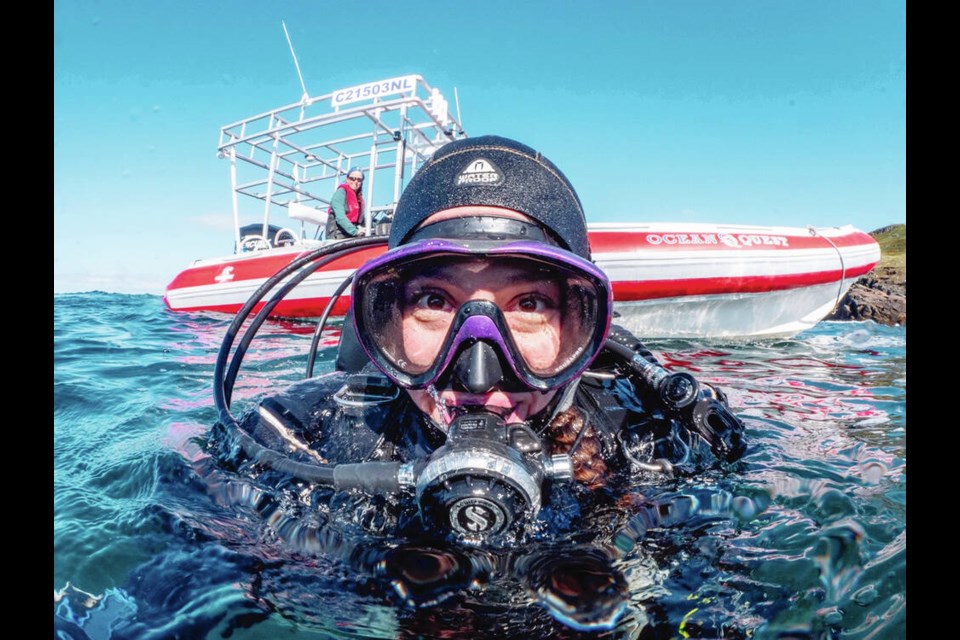Diver Tiare Boyes kept a careful watch on a thin line running between the surface of the water to the wreck of a downed Second World War-era bomber to help guide her down into the cold, dark waters of Gander Lake, Newfoundland, this past week.
The Saanich resident watched her diving gauges as she also closely followed a beam of light from diving partner Krystal Janicki to reach the Royal Canadian Air Force plane, which went down after its engine failed upon takeoff in September 1943.
All four men on board died and only one body, of Squadron Leader John G. MacKenzie, was recovered during a salvage effort at the time.
Divers confirmed the location of the plane Monday, 50 metres (164 feet) below the surface, upside down on a steep ledge.
Boyes, a certified technical diver and underwater photographer who does a lot of work in the underwater film industry, said the depth was not the challenging part — it was the lack of visibility in water she described as a red sepia colour.
“It’s like diving into a cup of very deep, very well-steeped tea.”
Boyes was among a team of divers backed by the Royal Canadian Geographical Society, the Shipwreck Preservation Society of Newfoundland and Labrador, and Ocean Quest Adventures, a Newfoundland-based adventure resort and dive facility.
The team confirmed the discovery of the Second World War-era B-24 Liberator Bomber that crashed into Gander Lake, Jill Heinerth — explorer in residence with the Royal Canadian Geographical Society — said in a statement.
The team consisted of divers from Canada, the U.S. and France. A 3D sonar scan taken in July shows an image of the plane, called Liberator 589D.
Images and video are being donated to the Shipwreck Preservation Society, said Heinerth, author of Into the Planet — My Life as a Cave Diver.
Search and salvage work carried out by military divers at the time of the crash was called off because of dangerous conditions. While MacKenzie’s body was being recovered, the plane slipped and sank to a depth beyond the range of the divers.
Researcher and diver Tony Merkle spent a decade trying to find the exact location of the aircraft, a goal accomplished on Monday.
Boyes said it was an “incredible honour’ to be there.
“It was also very sombre, because lives were lost on this plane. We definitely spent some time contemplating the loss of life and the sacrifices that these men made during World War II.”
The plane’s huge tires appear to be inflated but may be filled with water, she said.
Paint remains on the plane. “We could clearly see some hydraulic lines and some electrical lines and a power box of some sort.”
Boyes said the divers swam around the plane, which had a lot of jagged edges and a wing that appeared to be totally intact.
Her total dive was 30 minutes.
The Gander Lake dive was part of a Royal Canadian Geographic Society project called “The Great Island Expedition,” with divers travelling to various locations across Newfoundland.
The team has been documenting two U.S. navy Second World War shipwrecks — the USS Truxton and the USS Pollux — in the Burin Peninsula. It also explored underwater sites near Gros Morne National Park and is next going to carry out dives to mark the 80th anniversary of German U-boat attacks at Bell Island in 1942.
Taking part in the expedition has personal meaning to Boyes.
“Like a lot of people, I had relatives who fought in World War II. For me, it has always been very important to remember the sacrifices that an entire generation of people made during those years.
“I think it is really important to maintain those connections to our past,” she added. “There are fewer and fewer knowledge carriers.”
She wants people to think about the resiliency and hope that came out of that time and to make sure such stories are never forgotten.
Heinerth said the society’s role is to make Canada better known to Canadians and the world. “I imagine there are few Canadians that have a deep understanding of how WWII happened quite literally on what are now our shores.”
As for Boyes, her next stop will be the Arctic, to help document work on kelp, before she returns home to Saanich.
>>> To comment on this article, write a letter to the editor: [email protected]



